-
Paper Information
- Paper Submission
-
Journal Information
- About This Journal
- Editorial Board
- Current Issue
- Archive
- Author Guidelines
- Contact Us
International Journal of Internet of Things
2013; 2(1): 5-11
doi:10.5923/j.ijit.20130201.02
Internet of Things: Ubiquitous Home Control and Monitoring System using Android based Smart Phone
Rajeev Piyare
Department of Information Electronics Engineering, Mokpo National University, Mokpo, 534-729, Korea South
Correspondence to: Rajeev Piyare, Department of Information Electronics Engineering, Mokpo National University, Mokpo, 534-729, Korea South.
| Email: |  |
Copyright © 2012 Scientific & Academic Publishing. All Rights Reserved.
This paper presents a low cost and flexible home control and monitoring system using an embedded micro-web server, with IP connectivity for accessing and controlling devices and appliances remotely using Android based Smart phone app. The proposed system does not require a dedicated server PC with respect to similar systems and offers a novel communication protocol to monitor and control the home environment with more than just the switching functionality. To demonstrate the feasibility and effectiveness of this system, devices such as light switches, power plug, temperature sensor and current sensor have been integrated with the proposed home control system.
Keywords: Internet of Things, Smart Home, Home Automation, Android Smartphone, Arduino
Cite this paper: Rajeev Piyare, Internet of Things: Ubiquitous Home Control and Monitoring System using Android based Smart Phone, International Journal of Internet of Things, Vol. 2 No. 1, 2013, pp. 5-11. doi: 10.5923/j.ijit.20130201.02.
Article Outline
1. Introduction
- The Internet of Things (IoTs) can be described as connecting everyday objects like smart-phones, Internet TVs, sensors and actuators to the Internet where the devices are intelligently linked together enabling new forms of communication between things and people, and between things themselves[1]. Building IoTs has advanced significantly in the last couple of years since it has added a new dimension to the world of information and communication technologies. According to[2], it is expected that the number of devices connected to the Internet will accumulate from 100.4 million in 2011 to 2.1 billion by the year 2021, growing at a rate of 36% per year. In the year 2011, 80% machine to machine (M2M) connections were made over mobile networks such as 2G and 3G and it is predicted that by 2021, this ratio will increase to 93% since the cost related with M2M over mobile networks are generally cheaper than fixed networks as illustrated in Figure 1. Now anyone, from anytime and anywhere can have connectivity for anything and it is expected that these connections will extend and create an entirely advanced dynamic network of IoTs. The development of the Internet of Things will revolutionize a number of sectors, from automation, transportation, energy, healthcare, financial services to nanotechnology. IoTs technology can also be applied to create a new concept and wide development space for smart homes to provide intelligence, comfort and to improve the quality of life. Different devices and the appliances in the home such as lightings, air condition, home security and entertainment systems are now being connected to the Internet so that it can be controlled remotely using the Smart phones or Tablets. Not only devices can be controlled, but home environment can also be continuously monitored for maintaining certain desired temperature or monitoring amount of energy consumption[3]. Hence, this will contribute to overall cost reduction and energy saving which is one of the main concerns of today.
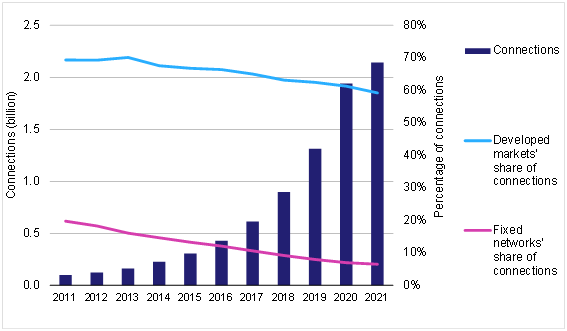 | Figure 1. M2M device connections and future predictions |
2. Related Work
- Home automation or Smart Homes (also known as domotic) can be described as introduction of technology within the home environment to provide convenience, comfort, security and energy efficiency to its occupants[5]. Adding intelligence to home environment can provide increased quality of life for the elderly and disabled people who might otherwise require caregivers or institutional care. There has been a significant increase in home automation in recent years due to higher affordability and advancement in Smart phones and tablets which allows vast connectivity. With the introduction of the Internet of Things, the research and implementation of home automation are getting more popular[6]. Much of the research attention has been given in academia. Various wireless technologies that can support some form of remote data transfer, sensing and control such as Bluetooth, Wi-Fi, RFID, and cellular networks have been utilized to embed various levels of intelligence in the home[7]. The studies in[4, 8-14] have presented Bluetooth based home automation systems using Android Smart phones without the Internet controllability. The devices are physically connected to a Bluetooth sub-controller which is then accessed and controlled by the Smart phone using built-in Bluetooth connectivity. However, due to limited range of operation (maximum up to 100 m) the system is unable to cope with mobility and can only be controlled within the vicinity. Researchers have also attempted to provide network interoperability and remote access to control devices and appliances at home using home gateways.[15] introduced a Wi-Fi based home control system using PC based web server which manages the connected home devices. Similar designs have also been presented in[16-19] where a dedicated web server, database and a web page have been developed to interconnect and manage the devices with the Internet. The disadvantages of these systems are twofold. Firstly, a high end personal computer has been utilized which not only increases the cost of installation but also increases the energy consumption. Secondly, development and hosting of web pages which also add to the cost. A GSM based communication and control for home appliances has also been presented by[20] where different AT commands are sent to the Home Mobile for controlling different appliances. The drawback of this system is that users are not provided with a graphical user interface and users have to remember different AT commands to control the connected devices.[21] proposed mobile IP based architecture and its potential applications in Smart homes security and automation without any actual deployment and testing. Lately few researchers have also presented use of Web services, Simple Object Access Protocol (SOAP) and Representational State Transfer (REST) as an interoperable application layer to remotely access home automation systems.[22] introduced a smart home management scheme over the Ethernet network based on XML SOAP standards. The drawback of using SOAP based Web a service is that it is complex and adds overhead to the client and server when parsing the message, resulting in slower operation and higher Bandwidth. REST[23] has been presented as a Web-based interaction for controlling household appliances using Web techniques such as HTTP caching and push messaging. Also a Web-based graphical user interface has been developed to manage the home devices. Home automation using Cloud computing has also been proposed by[24, 25] where users were able to control various lights and appliances within their home.The above mentioned systems have made significant contributions to the design and development of home automation systems. However, the existing works were mainly focused on switching and controlling home appliances or connected devices rather than remotely monitoring of home environment.
3. Proposed System and Architecture
3.1. Features of the Proposed System
- In order to address the mentioned issues of flexibility and functionality in the literature survey, we designed and implemented a novel, standalone, flexible and low cost home controlling and monitoring system using RESTful based Web services as an interoperable application layer. The system consists of a micro Web - server based on Arduino Ethernet, hardware interface modules and the Android compatible Smart phone app. The architecture presented in this work can be customized in different ways in order to accommodate different application scenarios with minimum recoding and design i.e. each time a new device is added to the micro Web-server, a new thread dedicated to the device is automatically created in the Smart phone app. Hence, the aim of the proposed work is not to incorporate expensive components such as high end personal computers. This system allows authorized home owners to remotely control and monitor connected devices at home using any Wi-Fi or 3G/4G enabled Smart phone which supports Java. The smart phone app provides a graphical user interface (GUI) for accessing and controlling the devices at home through server real IP.
3.2. Description of Proposed Architecture
- This section describes the proposed architecture and design of flexible and low cost home controlling and monitoring system. The architecture is divided into three layers: Home Environment, Home Gateway and Remote Environment (see Figure 2). Remote Environment represents authorized users who can access the system on their Smart phone app using the Internet via Wi-Fi or 3G/4G network. Home Environment consists of Home Gateway and a hardware interface module. The primary function of the Home Gateway for the proposed architecture is to provide data translation services between the Internets. The main component of the Home Gateway is a micro Web - server based on Arduino Ethernet. The main task of the server is to manage, control and monitor system components, that enables hardware interface modules to successfully execute their assigned task using actuators and to report server with triggered events via sensors.Hardware interface modules are directly interfaced with sensors and actuators through wires. It has the capabilities to control energy management systems like lightings, power plugs, HVAC (heating, ventilation, and air conditioning) systems and security systems such as door locks, and gate. For monitoring Home Environment the system supports sensors such as temperature, humidity and current.
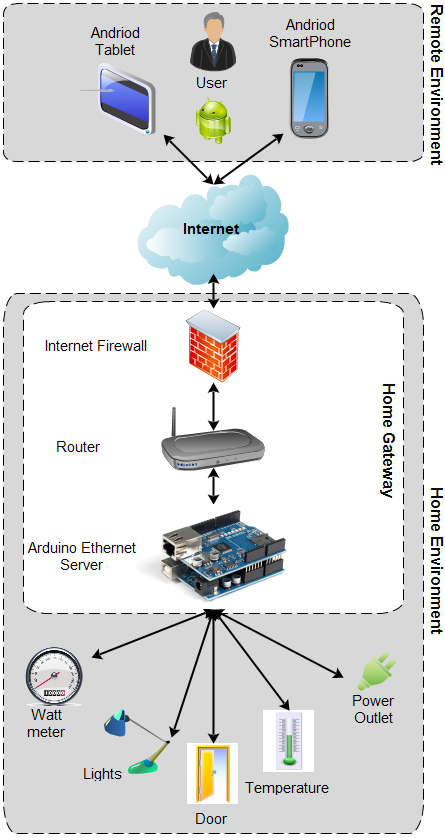 | Figure 2. A Overview of Conceptual architecture |
4. System Implementation
- As mentioned, the proposed ubiquitous home control and monitoring system consists of three main modules: the micro Web server, hardware interface module and the software package (Smart phone app). To demonstrate the feasibility and effectiveness of this system, devices such as light switches, power plug, temperature sensor and current sensor have been integrated with the proposed home control system. This section describes the system implementation details.
4.1. Software Development for Home Gateway
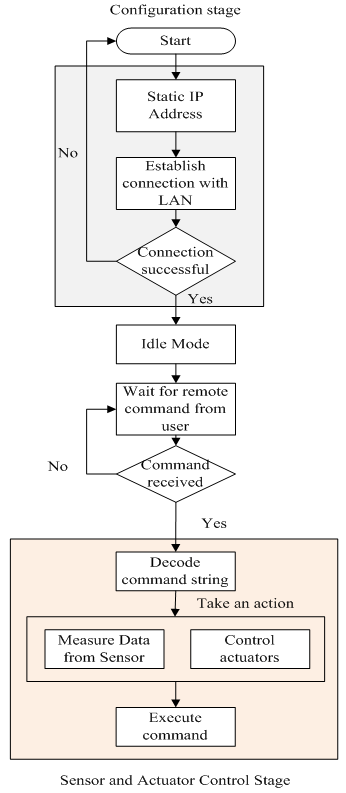 | Figure 3. Home Gateway flow chart for the connection establishment with the Internet |
4.2. Home Gateway Application Framework
- The access to Web services has to be easy, direct, open and interoperable. That is, the provided communication means and programming interfaces (APIs) shall be easy to implement on every platform and developing environment[26]. The most open and interoperable way to provide access to remote services or to enable applications to communicate with each other is to utilize Web services. There are two classes of Web services: Simple Object Access Protocol (SOAP) and Representational State Transfer (REST). RESTful is a much more lightweight mechanism than SOAP offering functionality similar to SOAP based Web services.Therefore, in our approach we have used the RESTful based Web service utilizing standard operation such as GET and POST requests that return JavaScript Object Notation (JSON) responses to communicate between the remote user and the micro Web server. JSON is a lightweight data-interchange format. It is easy for human beings to read and write. It is also simpler for machines to parse and generate messages than using XML. For example, to turn ON the light, an HTTP POST request is sent to the resource of the server as illustrated in Figure 4
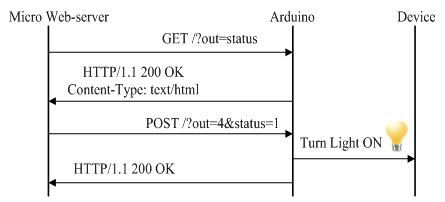 | Figure 4. Messages between Arduino and micro Web-server |
4.3. Smartphone Application and Features
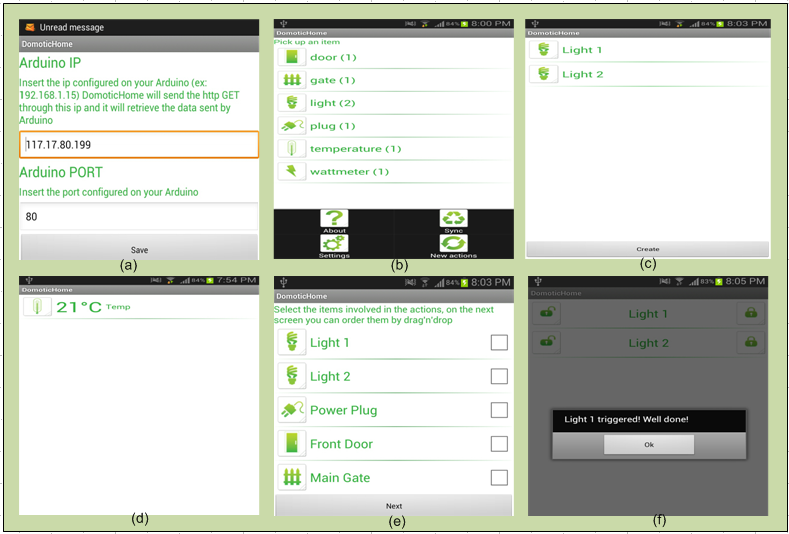 | Figure 5. Screenshots for Graphical user interface for the home control system |
4.4. Hardware Implementation and Home Automation Devices
- For proof of the concept, low cost and off the shelf electronics hardware is used to setup the test bench. The overall implementation diagram is illustrated in Figure 6.
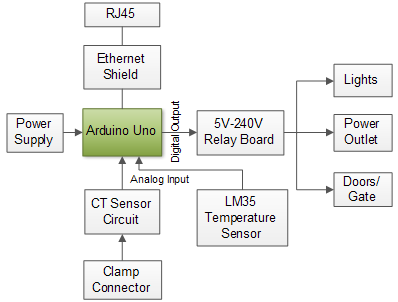 | Figure 6. Hardware architecture and implementation |
5. Conclusions
- In this paper, a novel architecture for low cost and flexible home control and monitoring system using Android based Smart phone is proposed and implemented. The proposed architecture utilizes RESTful based Web services as an interoperable application layer for communicating between the remote user and the home devices. Any Android based Smart phone with built in support for Wi-Fi can be used to access and control the devices at home. When a Wi-Fi connection is not available, mobile cellular networks such as 3G or 4G can be used to access the system. Future works will focus on creating a wireless network between the home server and the home devices using Zigbee and implementation of voice commands for controlling the application via voice.
ACKNOWLEDGEMENTS
- The This work was supported by Priority Research Centers program through the National Research Foundation of Korea (NRF) funded by the Ministry of Education, Science and Technology (2009-0093828) and MKEC (The Ministry of Knowledge Economy), Korea, under the ITRC (Information Technology Research Center) supported program supervised by the NIPA, National IT Industry Promotion Agency (NIPA-2013-H0301-13-2005).
Conflict of Interests
- The authors declare that there is no conflict of interests regarding the publication of this article.
 Abstract
Abstract Reference
Reference Full-Text PDF
Full-Text PDF Full-text HTML
Full-text HTML